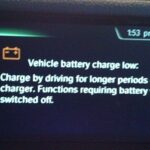The P0171 code, sometimes referred to as “Po171 Codigo,” indicates a system running too lean in bank 1. This is a common trouble code that many vehicle owners encounter, and it suggests that your engine is not receiving enough fuel in proportion to the air it’s taking in. Addressing a P0171 code promptly is important to maintain your vehicle’s performance and fuel efficiency, and to prevent potential engine damage over time. This article will guide you through the common causes and troubleshooting steps for a P0171 code.
One of the first and easiest steps in diagnosing a P0171 code is to inspect the air intake system. Start by checking your air filter. A clogged air filter can restrict airflow, leading to a lean condition. Replace it if it’s dirty. Next, examine the air ductwork from the air filter housing to the throttle body. Make sure there are no cracks or leaks that could allow unmetered air into the system.
 Engine Air Filter
Engine Air Filter
The Mass Air Flow (MAF) sensor is crucial for measuring the amount of air entering the engine. A dirty or malfunctioning MAF sensor can provide incorrect readings, causing a lean mixture. Cleaning your MAF sensor is a simple maintenance task that can often resolve a P0171 code. Use a dedicated MAF sensor cleaner and follow the product instructions carefully.
The Positive Crankcase Ventilation (PCV) valve and its associated hoses are another area to inspect. A faulty PCV valve or a cracked PCV hose can create a vacuum leak, drawing in extra air and leaning out the fuel mixture. Check the PCV valve and hose for any signs of damage and replace them if necessary. Pay close attention to the PCV hose connections as well, ensuring they are secure and airtight.
Vacuum leaks are a frequent culprit behind P0171 codes. Besides the PCV system, vacuum leaks can occur in various locations, including intake manifold gaskets, vacuum hoses, and around the throttle body. Listen for hissing sounds, which can indicate a vacuum leak. Carefully inspect all vacuum lines and connections. Sometimes, tightening the intake manifold bolts can help seal a leaking gasket, but replacement might be necessary for a permanent fix.
The Secondary Air Injection (SAI) system is designed to reduce emissions during cold starts. While less common, a malfunctioning SAI system can contribute to a P0171 code. Problems within the SAI system, such as a faulty pump or valve, can disrupt the air-fuel ratio. If you’ve addressed the more common causes and the P0171 code persists, investigating the SAI system might be the next step.
While less likely if your vehicle is running normally, fuel delivery issues can also cause a lean condition. A weak fuel pump or clogged fuel injectors could restrict fuel flow, leading to a P0171 code. However, if fuel delivery is the primary issue, you might experience other symptoms like poor engine performance or difficulty starting.
In conclusion, troubleshooting a P0171 code, or “po171 codigo”, involves systematically checking potential causes, starting with the simplest and most common. Begin with the air intake system, MAF sensor, and PCV system. Thoroughly inspect for vacuum leaks. If these steps don’t resolve the issue, consider the SAI system and potentially fuel delivery. By methodically diagnosing and addressing each possibility, you can effectively resolve the P0171 code and restore your vehicle’s optimal performance. If you require further assistance, consulting a qualified mechanic is always a recommended step.
